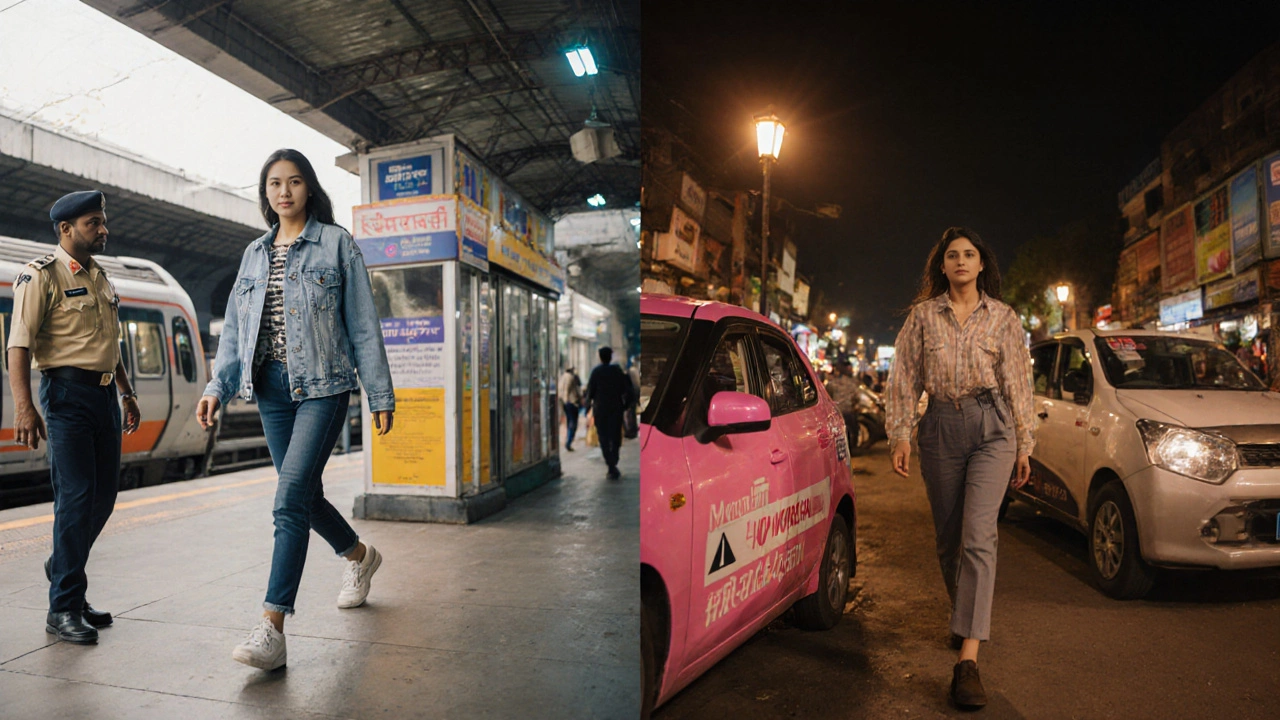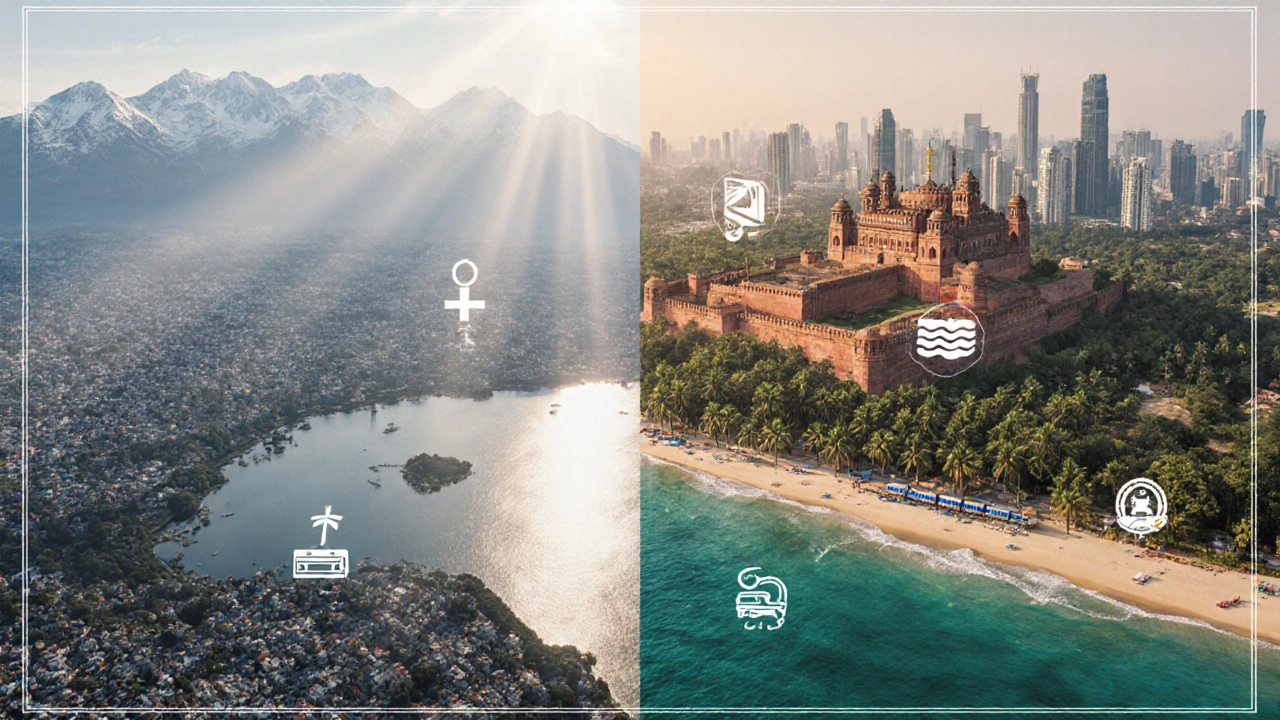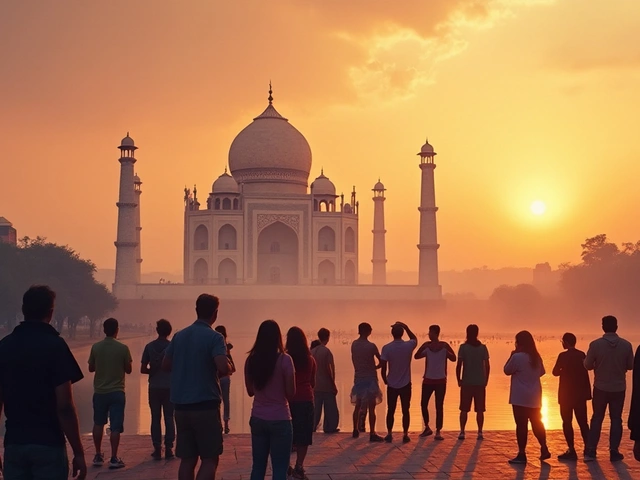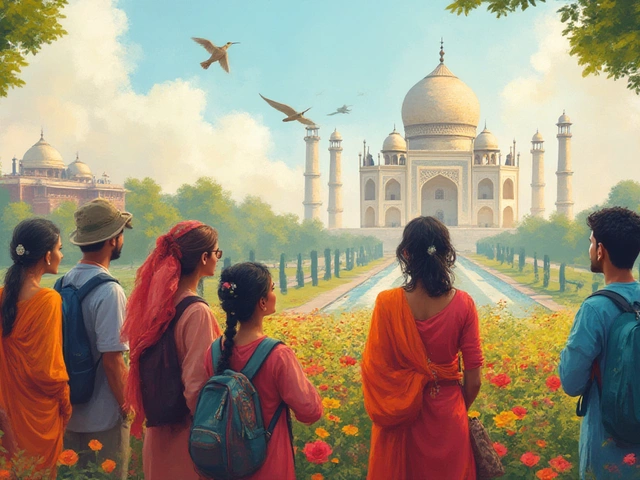North vs South India Safety Comparison Tool
North India
Historic sites, cultural heritage, adventure sports
South India
Coastal beauty, backwaters, healthcare facilities
Select a safety aspect and click "Compare" to see detailed analysis.
When it comes to travel safety in India, many wonder whether the northern states or the southern states offer a more secure experience. The answer isn’t a simple yes or no; it depends on what you value most-low crime rates, reliable health services, friendly locals, or robust transport. This guide breaks down the key safety factors, compares the two regions side‑by‑side, and gives you actionable tips to stay safe wherever you roam.
Understanding the Regions
North India is a geographic zone that includes states such as Delhi, UttarPradesh, Punjab, Rajasthan, and HimachalPradesh. It is known for its historic forts, bustling markets, and varied climate from chilly hills to scorching plains.
South India covers Karnataka, Kerala, TamilNadu, AndhraPradesh, and Telangana. The area is famous for its coastal beaches, lush backwaters, and a more relaxed tempo in daily life.
Both zones attract millions of tourists each year, but their safety landscapes differ in subtle ways.
Safety Dimension #1: Crime Rate
Crime statistics from the National Crime Records Bureau (NCRB) show that violent crime per 100,000 residents is marginally higher in some northern metros like Delhi and Lucknow compared with southern hubs such as Bangalore and Kochi. However, petty theft-pickpocketing and bag snatching-remains a common nuisance in crowded spots across the country.
Key takeaway: major tourist cities in the south tend to report lower violent‑crime rates, while north‑city crowds demand a keener eye on personal belongings.
Safety Dimension #2: Women Travelers
Women travel safety is a crucial metric for solo adventurers and families alike. Surveys by the Ministry of Tourism in 2023 rank southern states like Kerala, Karnataka, and TamilNadu among the most women‑friendly, citing higher police responsiveness and community awareness.
In the north, cities such as Delhi have launched women‑only cabs and dedicated helplines, yet reports of harassment in certain nightlife districts suggest staying vigilant after dark.
Safety Dimension #3: Health Facilities
Access to quality medical care can be a make‑or‑break factor during a trip. Health facilities in the south are often praised for their well‑equipped hospitals and English‑speaking staff, especially in Kerala’s public health system, which ranks among the world’s best per WHO data.
The north boasts premier institutions like AIIMS in Delhi and PGIMER in Chandigarh, yet the gap between urban and rural health services is wider in many northern states.

Safety Dimension #4: Transport Infrastructure
Reliable transport reduces the chance of accidents and stranded situations. Transport infrastructure in southern metros such as Bangalore, Hyderabad, and Chennai includes well‑maintained roads, extensive metro networks, and reputable ride‑share services.
North India’s rail network is among the busiest in the world, but overcrowding and occasional delays can cause safety concerns. Road quality varies starkly: hill routes in Himachal are safe but winding, while some highway stretches in UttarPradesh are prone to potholes.
Safety Dimension #5: Natural Disaster Risk
Geography dictates exposure to natural hazards. The south faces cyclone threats along the Bay of Bengal and occasional flooding in Kerala’s monsoon season. However, robust early‑warning systems and disaster‑relief plans have improved resilience.
North India endures severe winter cold in the Himalayas, seismic activity in the Indo‑Gangetic plain, and occasional landslides in the foothills. Travelers to high‑altitude areas should be prepared for sudden weather changes.
Safety Dimension #6: Police Presence and Tourist Support
Strong local law enforcement can deter crime and aid tourists. Police presence in tourist hotspots like Delhi’s Connaught Place or Jaipur’s old city has increased with dedicated tourist police units.
Southern destinations such as Mysore, Fort Kochi, and Pondicherry maintain visible patrols and multilingual assistance desks, often earning higher satisfaction scores in tourist surveys.
Quick Comparison Table
| Aspect | North India | South India |
|---|---|---|
| Violent Crime Rate | Moderate (higher in metros) | Low to moderate |
| Women‑Friendly Index | Improving, but varies by city | Generally high |
| Health Facility Quality | World‑class in major cities, uneven elsewhere | Consistently good, especially in Kerala |
| Transport Safety | Extensive rail, mixed road conditions | Modern metros, better road upkeep |
| Natural Disaster Risk | Earthquakes, winter cold, landslides | Cyclones, monsoon flooding |
| Police & Tourist Support | Special tourist police in key zones | Visible patrols, multilingual desks |
Practical Tips for Staying Safe Anywhere in India
- Carry a photocopy of your passport and keep the original in a hotel safe.
- Use reputable ride‑share apps; verify driver details before hopping in.
- Dress modestly in rural areas to avoid unwanted attention.
- Stay in well‑reviewed accommodations that have 24‑hour reception.
- Download the Indian government’s ‘Sukoon’ app for emergency alerts and quick police contact.
- When traveling at night, stick to well‑lit streets and avoid isolated transport hubs.
When to Choose North India Over South India
If your itinerary centers on iconic heritage sites like the Taj Mahal, forts of Rajasthan, or the Himalayan trekking routes, the north offers unmatched cultural depth. For adventure seekers, hill stations such as Shimla, Manali, and Leh provide thrilling experiences, albeit with higher altitude risks. Take extra precautions for weather changes and always inform someone of your trek plans.
When to Lean Toward South India
Travelers craving a laid‑back vibe, lush greenery, and easy access to quality health care often prefer the south. Coastal cities like Kochi and Goa (though technically in the west, managed under southern tourism boards) provide beach relaxation with lower crime concerns. Backwater cruises in Kerala are safe, especially when booked through reputable operators.
Bottom Line
Neither region is inherently dangerous; both have safe pockets and spots that demand caution. Your personal comfort level, itinerary focus, and willingness to adapt to local customs will tip the scale. By staying informed, using the tips above, and respecting local norms, you can enjoy a rewarding and secure adventure in either north or south India.
Frequently Asked Questions
Is Delhi safer than Bangalore for solo female travelers?
Bangalore generally scores higher on women‑friendliness due to its tech‑city vibe and responsive police. Delhi has improved safety measures, but solo females often report feeling more comfortable in Bangalore’s modern neighborhoods and well‑lit metro stations.
What are the biggest natural hazards in South India?
Cyclones along the Bay of Bengal and monsoon‑related flooding are the primary concerns. Coastal resorts usually have sturdy shelters and clear evacuation routes, so staying updated via local news reduces risk.
How reliable are ride‑share services in smaller towns?
In major cities, Uber and Ola are highly reliable. In smaller towns, local app‑based services may be limited; it’s safer to book a prepaid taxi through your hotel or use reputable local operators.
Do I need travel insurance for health emergencies?
Absolutely. While public hospitals in the south are affordable, private facilities in the north can be costly for foreigners. A comprehensive travel insurance plan covering hospitalization and evacuation is essential.
Are there any regions I should avoid completely?
Most tourist‑friendly zones are safe year‑round. However, border areas with ongoing political tensions-such as parts of Jammu & Kashmir and some remote tribal districts-are best avoided unless you have specific local guidance.



